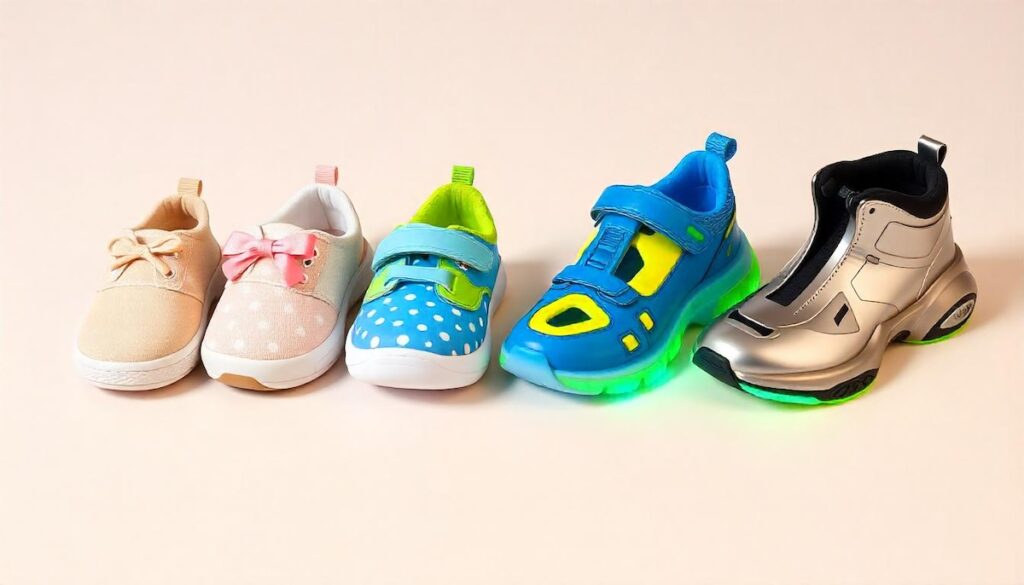Choosing the right shoes for your toddler is key to their comfort and foot health. Choosing the right shoes for babies as they start to walk is vital to support their developmental milestones and exploring. Good shoes support their growing feet and let them move around easily. But there are many myths about toddler shoes that can fool parents.

Some people think buying bigger shoes will save you money in the long run or that using hand me down shoes is okay. These myths can cause discomfort and harm foot development.
In this post, we’ll help parents avoid these mistakes when buying toddler shoes. We’ll cover what to look out for and give you tips on how to make smart decisions so your child’s feet are comfortable and supported.
Toddler Foot Development
Toddler feet go through a lot of changes as they grow. Unlike adult feet, toddler feet are softer and more pliable. They have more cartilage which turns into bone over time. You need to measure children’s feet regularly to ensure the right fit as they grow.
Toddler Foot Development Stages:
Rapid Growth: Toddler feet can grow up to half a size every few months. This rapid growth requires regular checks to ensure their shoes fit.
Arches Forming: Toddlers have flat feet because of a layer of fat on the arch. As they grow, the arch starts to form, usually by age 3.
Coordination and Strength: Walking and running help strengthen the muscles and ligaments in their feet. Good shoes support these activities by giving the right flexibility and support. You need multiple pairs of shoes to accommodate different activities and comfort.
Why Good Footwear Matters:
Support for Growth: Shoes that fit and support help align the feet correctly, reducing the risk of flat feet or heel pain.
Comfort and Safety: Well-fitted shoes prevent blisters and pressure points so toddlers can move freely and safely.
Natural Movement: Flexible soles allow natural foot movement, essential for strong muscles and healthy walking patterns.
Buying right toddler shoes is key to these developmental milestones. Making sure shoes are both comfortable and supportive can make a big difference to your child’s foot health.
Mistakes Parents Make When Buying Toddler Shoes (and How to Avoid Them)

Wrong Size
Getting the right size for toddler shoes is key. An ill-fitting shoe, whether too big or too small, can affect your child’s walking and comfort. And there are many stylish and comfortable kids’ shoes out there catering to different age groups and both aesthetics and comfort.
Consequences:
Too Big: Too big shoes can cause tripping.
Too Small: Too tight shoes can cause discomfort, blisters and long-term foot problems.
Tips for Sizing:
Measure Both Feet: One foot is often slightly bigger than the other. Always fit the bigger foot.
Use a Foot Measuring Device: Available at most shoe stores.
Leave Some Wiggle Room: There should be about a thumb’s width between the tip of the shoe and your toddler’s longest toe.
Buying Secondhand Shoes
Buying secondhand shoes might seem economical but there are hidden risks. Instead you can shop online for new shoes and have a wide range of stylish and comfortable options for your kids.
Problems:
Foot Shape Mismatch: Used shoes have moulded to another child’s feet, which may not match your toddler’s foot shape.
Hidden Wear and Tear: Worn-out soles or insides may not provide enough support.
Buying new shoes made for your child ensures they get the right fit and support for their growing feet.
Stiff Soles
Flexibility in toddler shoes is important for foot development.
Why Flexibility Matters:
Natural Movement: Flexible soles allow natural movement and help in muscle development.
Comfort: Rigid soles can be uncomfortable and restrict movement.
Recommendations:
Look for lightweight shoes with soft soles.
Brands that offer flexible yet supportive designs are good for toddlers who are just starting to walk.
Ignoring Regular Sizing
Toddler’s feet grow fast – sometimes half a size every few months. Regularly measuring your child’s feet ensures they always wear the right size.
Practical Tips:
Frequent Measurements: Measure every 2-3 months.
Track Growth: Keep a record of your child’s foot measurements to notice any sudden changes.
Try On Both Shoes: Have your child try on both shoes and walk around in them.

Appearance Over Functionality
It’s easy to get tempted by cute designs, but functionality should always come first when choosing toddler shoes.
Look For:
Good Traction: Prevents slipping and falling.
Flexibility: Allows natural foot movement.
Breathable Materials: Keeps little feet dry and comfortable.
Functional features will keep your toddler safe and comfortable as they explore.
How to Choose Toddler Shoes Without Breaking the Bank!
You don’t have to look far to find affordable options for toddlers. There are several brands that produce high quality, budget friendly shoes that cater to little feet.
Carter’s: Known for their durable and cute designs, Carter’s has a wide range of toddler shoes that balance quality and price. Their shoes often have flexible soles and breathable materials to support foot development.
Stride Rite: This brand is synonymous with children’s shoes. Stride Rite shoes are designed for growing feet with good arch support, flexibility and cushioning. They have sales and discounts frequently so it’s a good option for budget conscious parents.
Cat & Jack by Target: A popular choice among parents, Cat & Jack has trendy yet practical shoes at affordable prices. They have various styles that includes non-slip soles and adjustable straps.
Payless ShoeSource: With an extensive selection and frequent promotions, Payless ShoeSource is a go to for many families. Their toddler shoes are comfortable and affordable with plenty of options for different foot shapes.
H&M Kids: H&M Kids has a wide range of fashionable yet functional shoes for toddlers. Their shoes often have soft soles and easy to wear designs for comfort without compromising on style.
You can get the support your child needs without breaking the bank. Comfort and functionality within budget is possible with these trusted brands in children’s shoes.
Conclusion: How to Make Informed Decisions When Buying Shoes for Your Little Ones
Supporting your toddler’s feet and being comfortable can be overwhelming. But with this buying guide summary in mind:
Prioritize Accurate Sizing: Measure your child’s feet regularly to avoid discomfort and potential development issues.
Flexibility: Choose shoes with soft soles that allow natural movement.
Function Over Fashion: Focus on practical features like traction and breathability.
Taking these steps helps safeguard your child’s foot health while making shoe shopping a breeze.








